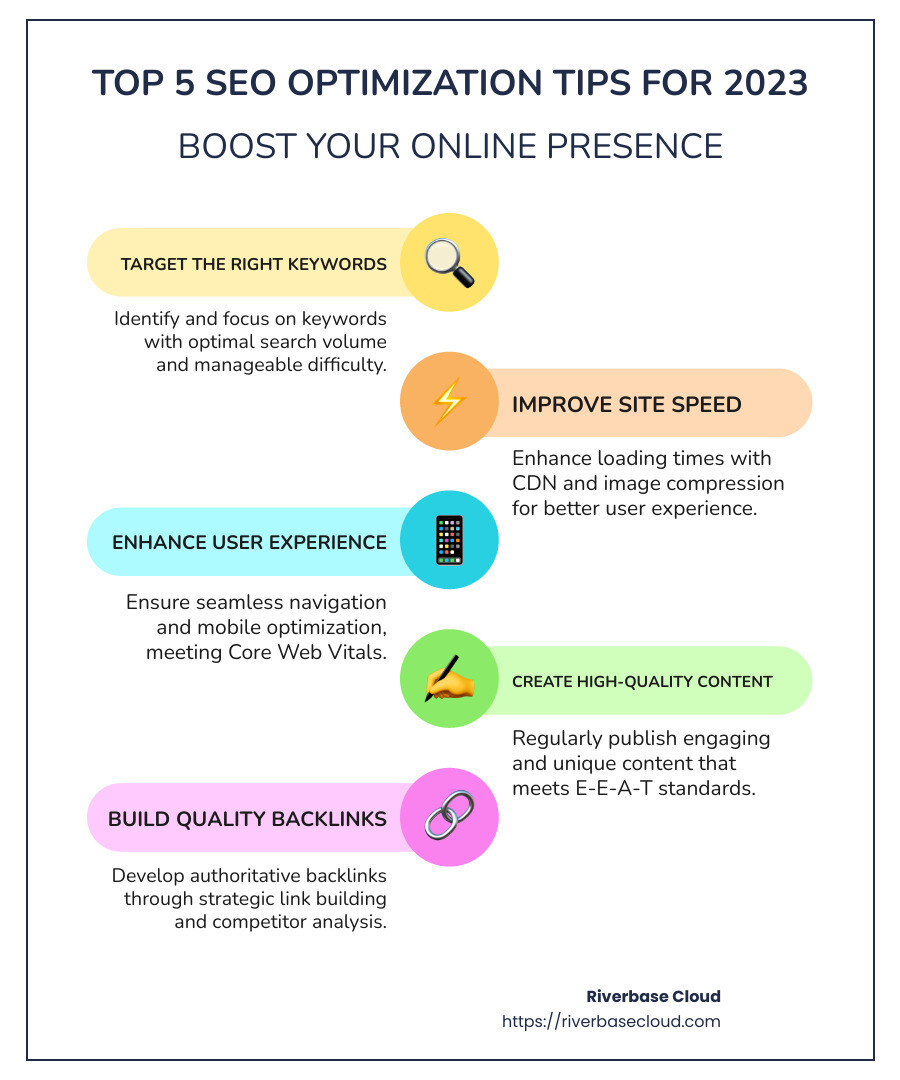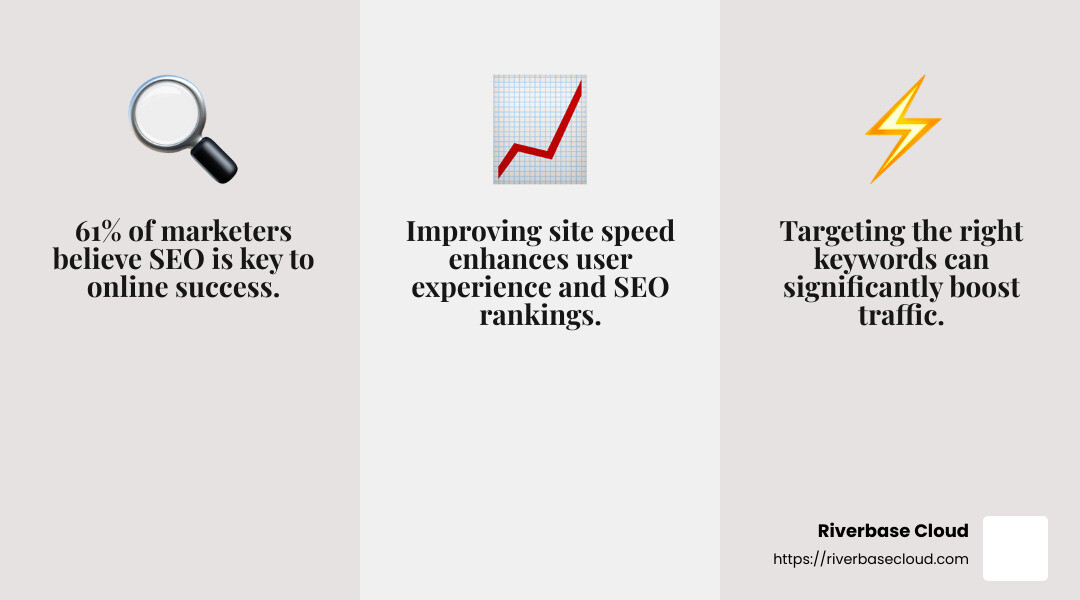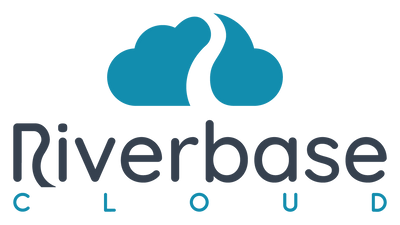SEO optimization tips can transform your digital presence. They help your website appear more prominently in search results, driving organic traffic and improving your online visibility. Here's a quick breakdown of essential tips to set you on the right path:
- Target the Right Keywords: Ensure your content aligns with what your audience is searching for.
- Improve Site Speed: Faster loading pages improve user experience and boost Google rankings.
- Create High-Quality Content: Publish informative, engaging, and unique content regularly.
- Improve User Experience: Optimize your site for seamless navigation and mobile usability.
- Build Quality Backlinks: Cultivate reputable links pointing back to your site to improve authority.
Having a fundamental understanding of SEO is crucial. It involves knowing how search engines like Google index and rank content. The key is meeting user intent, or the reason behind a user's search query. When your content satisfies this intent, you're likely to experience increased engagement and traffic.
As Gary Gilkison, I've steerd the intricacies of SEO optimization tips through years in digital marketing and AI-driven strategies. My experience in optimizing campaigns, improving search rankings, and crafting user-focused content ensures practical and actionable guidance in SEO.

Learn more about SEO optimization tips:
- AI-driven SEO strategies
- Google ranking optimization
- local business promotion
Understanding SEO Optimization Tips
When diving into SEO optimization tips, grasp some key concepts that can significantly impact your strategy. Let's explore the 80-20 rule, search intent, and keyword placement.
The 80-20 Rule in SEO
The 80-20 rule, also known as the Pareto Principle, suggests that 80% of your results come from 20% of your efforts. In SEO, this means focusing on the most impactful strategies can yield the best results. Instead of spreading your resources thin, concentrate on high-impact activities like optimizing top-performing pages, targeting high-conversion keywords, and building quality backlinks. This strategic focus ensures maximum return on investment.
Understanding Search Intent
Search intent is the why behind a user's query. It's crucial to align your content with what users are looking for. There are four main types of search intent:
- Informational: Users seek knowledge or answers. Example: "How to bake a cake."
- Navigational: Users look for a specific website. Example: "Facebook login."
- Commercial: Users research products or services. Example: "Best laptops 2023."
- Transactional: Users intend to make a purchase. Example: "Buy iPhone 14."
By understanding and targeting the correct search intent, your content can better serve your audience's needs, leading to higher engagement and satisfaction.
Strategic Keyword Placement
Keywords are the bridge between your content and your audience. But it's not just about stuffing keywords into your content. Strategic placement is key. Here’s how to do it effectively:
- Title Tags and Meta Descriptions: Include your primary keyword to help search engines understand your page's content.
- First 100 Words: Mention your main keyword early to set the context for both users and search engines.
- Headings and Subheadings: Use keywords naturally to organize content and improve readability.
- Image Alt Text: Describe images with relevant keywords for better accessibility and SEO.
Proper keyword placement can boost your visibility in search results while maintaining a natural flow for readers.
By focusing on these SEO optimization tips, you can improve your website's performance and better meet your audience's needs.

Next, we'll dive into the top five SEO tips for 2023, starting with how to Target the Right Keywords.
Top 5 SEO Optimization Tips for 2023
In the changing world of SEO, staying ahead means adapting to the latest trends and techniques. Here are the top five SEO optimization tips for 2023 that can lift your website's performance:
1. Target the Right Keywords
Finding the right keywords is a game-changer. Start by conducting thorough keyword research to identify terms with high search volume and low competition. Tools like Google's Keyword Planner can help you find these golden opportunities.
Focus on long-tail keywords—these are specific phrases that attract more targeted traffic. For instance, instead of just using "shoes," try "best running shoes for flat feet."

2. Improve Site Speed
A fast website is crucial. Not only does it improve user experience, but it also boosts your rankings. Google uses page speed as a ranking factor, so aim for a Lighthouse performance score close to 100.
To achieve this, optimize images by compressing them, use a Content Delivery Network (CDN) to reduce server load, and minimize scripts that slow down your site.
3. Improve User Experience
User experience is key to keeping visitors on your site longer. Ensure easy navigation with clear menus and intuitive design. Optimize for mobile devices, as mobile searches continue to rise.
Pay attention to Core Web Vitals—these are metrics that measure the speed, responsiveness, and visual stability of your site. Improving these can lead to higher engagement and better rankings.
4. Create High-Quality Content
Content is king. High-quality, unique content not only attracts visitors but also keeps them engaged. Focus on readability and ensure your content meets E-E-A-T (Experience, Expertise, Authority, Trustworthiness) standards. This builds trust with your audience and search engines.
Use lists, bullet points, and short paragraphs to improve readability. Regularly update old content to keep it relevant and valuable.
5. Build Quality Backlinks
Backlinks are a vote of confidence from other websites. They boost your domain authority and improve search visibility. Focus on acquiring links from reputable sites in your industry.
Engage in competitor analysis to find who’s linking to your competitors but not to you. Reach out to these sites with valuable content that they might want to link to.
By implementing these SEO optimization tips, you can significantly improve your website's performance in 2023 and beyond.
Next, we'll explore advanced SEO strategies, including structured data and featured snippets.
1. Target the Right Keywords
When it comes to SEO optimization tips, targeting the right keywords is absolutely essential. It's like finding the perfect bait for your fishing hook—get it right, and you'll reel in more visitors.
Keyword Research
Start with keyword research to understand what your audience is searching for. Tools like Semrush’s Keyword Magic Tool provide insights into what keywords your competitors rank for and what opportunities you might be missing. Enter a broad term related to your business, and you'll get a list of keyword ideas, complete with search volume and difficulty.
Long-tail keywords are your best friends here. They consist of three or more words and are less competitive, making it easier to rank. For example, instead of targeting "digital marketing," go for something like "digital marketing tips for beginners."
Search Volume
Next, consider the search volume of each keyword. This tells you how often a keyword is searched for each month. High search volume means more potential traffic but often comes with higher competition. A good strategy is to find a balance between search volume and competition.
For instance, a keyword with 1,000 monthly searches and moderate competition might be a better target than one with 10,000 searches but fierce competition.
Keyword Difficulty
Keyword difficulty measures how hard it is to rank for a particular keyword. Tools usually provide this as a percentage—higher percentages mean tougher competition. Aim for keywords with a lower difficulty score to improve your chances of ranking.
For example, if "best running shoes" has a high difficulty, you might target "best running shoes for flat feet" if it has a lower difficulty but still decent search volume.
By focusing on the right keywords, you set a strong foundation for your SEO strategy, ensuring your content reaches the right audience and boosts your site's visibility.
Next, we'll dive into how improving your site's speed can further improve your SEO performance.
2. Improve Site Speed
Improving your site's speed is one of the most crucial SEO optimization tips. A fast website not only improves user experience but also positively impacts your rankings on search engines like Google.
Page Speed
Imagine clicking on a link and waiting...and waiting. Frustrating, right? Page speed is a key factor in your site's success. Google considers it when ranking pages, so a slow site can hurt your visibility.
Use tools like PageSpeed Insights to check your site's speed. This tool provides a detailed analysis of your site's performance and offers suggestions for improvement.
Did you know? According to a study, 79% of dissatisfied online shoppers are unlikely to return to a site due to poor performance.
Use a CDN
A Content Delivery Network (CDN) can significantly boost your site's speed. CDNs store your site’s content on multiple servers around the globe. When a user accesses your site, the CDN delivers content from the server closest to them, reducing load times.
Popular CDN providers include Cloudflare and Akamai. By using a CDN, you ensure that your site loads quickly for users, no matter where they are located.
Quick Tip: Test your site with and without the CDN to see the difference in speed.
Image Compression
Large images can slow down your site, leading to a poor user experience. Image compression is a simple yet effective way to speed things up. Tools like TinyPNG and Kraken can compress images without losing quality.
Steps for Image Compression:
- Choose the right format: Use JPEG for photos and PNG for graphics with fewer colors.
-
Optimize filenames: Use descriptive filenames like
blue-sneakers.jpginstead ofimage1.jpg. - Add alt tags: These help with SEO and improve accessibility.
- Use responsive images: Ensure images adjust to different screen sizes.
By focusing on these aspects of site speed, you can improve user experience and improve your site's SEO performance.
Next, we'll explore how improving user experience can further boost your website’s performance.
3. Improve User Experience
Enhancing user experience is key to keeping visitors on your site and boosting your SEO optimization tips game. A user-friendly website not only delights your visitors but also signals search engines that your site is worth ranking higher.
Site Navigation
Imagine walking into a store and not knowing where anything is. Frustrating, right? That's what a poorly organized website feels like to users. Site navigation should be intuitive and straightforward.
Tips for Better Navigation:
- Use clear labels: Ensure menu items are easy to understand. Avoid jargon.
- Limit menu items: Stick to 5-7 main items to avoid overwhelming users.
- Include a search bar: Helps users find what they need quickly.
- Breadcrumbs: These show users where they are on the site and how to get back.
Fact: Easy navigation can reduce bounce rates, keeping users on your site longer, which is a positive signal for search engines.
Mobile Optimization
With 60% of internet traffic coming from mobile devices, having a mobile-friendly site is essential. Google prioritizes mobile-friendly sites in its rankings.
Steps for Mobile Optimization:
- Responsive design: Ensure your site adjusts to different screen sizes.
- Avoid Flash: It’s not supported on most mobile devices.
- Optimize buttons: Make them large enough to tap easily with a finger.
- Test regularly: Use tools like Google's Mobile-Friendly Test to ensure your site is up to par.
Stat: 79% of smartphone users have made a purchase using their device in the last six months. A mobile-friendly site can significantly impact your sales.
Core Web Vitals
Core Web Vitals are a set of metrics that Google uses to measure user experience on a page. They focus on three main aspects: loading, interactivity, and visual stability.
Key Metrics:
- Largest Contentful Paint (LCP): Measures loading performance. Aim for LCP to occur within 2.5 seconds of when the page first starts loading.
- First Input Delay (FID): Measures interactivity. Strive for an FID of less than 100 milliseconds.
- Cumulative Layout Shift (CLS): Measures visual stability. Keep CLS under 0.1 to ensure content doesn’t shift unexpectedly.
Use tools like Google Search Console to monitor and improve these metrics.
By focusing on these areas, you can create a seamless user experience that not only pleases visitors but also boosts your SEO rankings.
Next, we'll dive into creating high-quality content that captivates your audience and improves your site's authority.
4. Create High-Quality Content
Creating high-quality content is one of the most effective SEO optimization tips you can employ. It engages your audience, builds trust, and signals to search engines that your site is a valuable resource.
Unique Content
Unique content is king in SEO. It sets you apart from competitors and provides value that can't be found elsewhere. Google loves content that is original and fresh. Avoid copying from other sites; instead, offer your unique perspective or insights.
Example: A study highlighted on Backlinko showed that updating old content with new insights and data can boost organic traffic by up to 88.3%. This proves the power of keeping your content unique and up-to-date.
Readability
Readability is crucial for keeping your audience engaged. If your content is easy to read, users are more likely to stick around. Use simple language and short sentences. Break up text with headings, bullet points, and visuals to make it more digestible.
Tips for Improving Readability:
- Use simple language: Write as if you're explaining the topic to a friend.
- Short paragraphs: Keep them to 3-4 lines to avoid overwhelming readers.
- Headings & subheadings: Organize content with a clear hierarchy.
- Lists: Use bullet points or numbered lists to highlight key points.
Fact: According to research, content with a readability score of 60 or higher (eighth- or ninth-grade level) is more likely to rank well on search engines.
E-E-A-T: Experience, Expertise, Authoritativeness, Trustworthiness
E-E-A-T is a framework used by Google to assess content quality. It stands for Experience, Expertise, Authoritativeness, and Trustworthiness. These elements are key to building a strong online presence.
- Experience: Share personal experiences or case studies to demonstrate knowledge.
- Expertise: Provide in-depth and accurate information. Use data and research to back up claims.
- Authoritativeness: Cover topics extensively to establish your site as a go-to resource.
- Trustworthiness: Be transparent and honest. Include author bios and contact information to build trust with your audience.
Quote: "Google loves content that shows experience, expertise, authoritativeness, and trustworthiness (E-E-A-T)." - Riverbase Cloud
By focusing on these elements, you can create content that not only captivates your audience but also improves your site's authority in the eyes of search engines.
Next, we'll explore how to build quality backlinks to further boost your site's performance.
5. Build Quality Backlinks
Building quality backlinks is crucial for boosting your site's authority and search engine rankings. Think of backlinks as votes of confidence from other websites. The more you have from reputable sources, the higher your domain authority and credibility.
Link Building
Link building is the process of getting other websites to link back to your site. It's like networking for your website—building relationships with other sites to gain credibility and traffic.
Guest Posting: Write articles for other blogs in your niche. Include a link back to your site. This not only drives traffic but also builds authority.
Broken Link Building: Find broken links on other sites and suggest your content as a replacement. It's a win-win: they fix a broken link, and you gain a backlink.
Unlinked Mentions: Monitor the web for mentions of your brand. If someone talks about you without linking, reach out and ask for a link.
Case Study: A post on Backlinko showed that creating unique industry studies can generate thousands of backlinks without much outreach. This is because data-backed content is highly valuable and often cited by others.
Domain Authority
Domain authority (DA) is a score that predicts how well a website will rank on search engines. It's influenced by the quality and quantity of backlinks.
High-Quality Links: Focus on getting links from authoritative sites. One link from a high-DA site is worth more than many from low-DA sites.
Diverse Link Profile: Aim for a variety of links from different sources. This signals to search engines that your site is a trusted resource.
Tip: Use tools like Ahrefs or SEMrush to analyze your site's DA and identify opportunities for improvement.
Competitor Analysis
Analyzing your competitors' backlink profiles can reveal new opportunities for your own site.
Backlink Gap Tool: Tools like SEMrush's Backlink Gap can show you which domains link to your competitors but not to you. These are potential targets for your link-building efforts.
Steal Competitors’ Backlinks: If a site links to your competitor, they might link to you too—especially if you offer similar or better content.
Example: A roofing company might find that their competitors have links from home improvement blogs. By reaching out to these blogs with valuable content, they can acquire similar backlinks.
By focusing on these SEO optimization tips for building quality backlinks, you can improve your site's authority and improve its performance in search engine results.
Next, we'll dive into advanced SEO strategies to further lift your site's capabilities.
Advanced SEO Strategies
Ready to take your SEO game to the next level? Let's explore some advanced strategies that can give your website an edge over the competition.
Structured Data
Structured data is like giving search engines a map to your content. It helps them understand your site better, which can lead to improved visibility in search results.
What Is It? Structured data uses a specific vocabulary (like Schema.org) to mark up your content. This helps search engines understand the context of your content.
Why Use It? Implementing structured data can lead to rich results, like star ratings or event details, which make your listings stand out.
How to Implement: Use Google’s Structured Data Markup Helper to generate code that you can add to your site. Focus on marking up important elements like articles, products, and reviews.
Example: A recipe blog using structured data might show up in search results with a picture, cooking time, and rating—all thanks to structured data.
Featured Snippets
Featured snippets are the holy grail of search results. These are the boxes at the top of Google that directly answer a user's question.
Why They Matter: Capturing a featured snippet can dramatically increase your click-through rate, as it positions your content as the authoritative answer.
How to Optimize: Identify questions your audience is asking and provide clear, concise answers in your content. Use headings and lists to structure your answers, as these formats are often used in snippets.
Case Study: A site optimized for snippets saw a significant traffic boost by tailoring content to directly answer common questions, resulting in a featured snippet.
Topic Clusters
Topic clusters are a way to organize your content around a central theme, known as a pillar page, with related subtopics linking back to the pillar.
Why Use Them? This strategy improves site structure and helps search engines understand the relationship between content pieces, boosting your SEO.
How to Create: Start with a broad topic (the pillar), then create detailed subtopics (clusters) that link back to the pillar. This creates a web of content that covers the topic comprehensively.
Example: If your pillar page is about "SEO Strategy," your clusters could include "Keyword Research," "On-Page SEO," and "Technical SEO."
By implementing these advanced SEO optimization tips, you can improve your site's visibility, attract more traffic, and establish your authority in your niche.
Next, we'll address common questions about SEO optimization tips to clear up any lingering doubts.
Frequently Asked Questions about SEO Optimization Tips
How do I optimize my SEO?
Optimizing your SEO involves several key steps that can significantly improve your website's visibility and performance:
Keyword Research: Start by identifying the keywords your audience is searching for. Use tools like Google’s Keyword Planner to find terms with high search volume and low competition. This forms the foundation of your SEO optimization tips.
On-Page SEO: Ensure your page titles, headers, and meta descriptions include your target keywords. This helps search engines understand what your page is about.
Content Quality: Create high-quality, original content that provides value to your audience. Focus on readability and include elements like bullet points and images to make your content engaging.
Technical SEO: Improve your site’s speed and mobile-friendliness. Use tools like PageSpeed Insights to identify areas for improvement.
Backlink Building: Earn backlinks from reputable websites to boost your domain authority. This can be achieved by creating shareable content, such as infographics or in-depth guides.
By focusing on these areas, you can improve your website’s SEO and attract more organic traffic.
What is the 80-20 rule for SEO?
The 80-20 rule in SEO suggests that 80% of your results come from 20% of your efforts. This means focusing on the most impactful activities can yield significant returns. Here’s how you can apply this rule:
Prioritize High-Impact Keywords: Instead of targeting hundreds of keywords, focus on a few high-impact ones that drive the most traffic and conversions.
Content Focus: Spend more time on creating a few pieces of high-quality content rather than churning out numerous low-quality articles.
Technical Improvements: Identify and fix the most critical technical issues on your site that affect user experience and rankings.
By applying the 80-20 rule, you can streamline your efforts and focus on the strategies that provide the most significant benefits.
What is the best SEO strategy?
The best SEO strategy is one that is comprehensive and adaptable. Here’s a blueprint to guide you:
Understand Your Audience: Knowing who your audience is and what they need is crucial. Tailor your content to meet their search intent.
Content is King: Regularly produce high-quality content that addresses your audience's needs and incorporates relevant keywords naturally.
Technical Excellence: Ensure your site is technically sound. This includes having a fast-loading site, mobile optimization, and secure connections (SSL).
Link Building: Develop a robust link-building strategy to acquire high-quality backlinks from authoritative sites.
Continuous Monitoring and Adaptation: SEO is not a set-it-and-forget-it strategy. Use tools like Google Analytics to monitor your performance and adjust your strategies as needed.
By implementing these strategies, you can build a strong foundation for your SEO efforts and achieve long-term success.
Next, let's explore how Riverbase Cloud can support your SEO journey with managed AI solutions and AI-driven marketing.
Conclusion
As we've explored various SEO optimization tips, it's clear that a strategic approach is crucial for elevating your website's performance. At Riverbase Cloud, we specialize in providing Managed-AI solutions that seamlessly integrate cutting-edge technology with expert human oversight to drive real results. Our focus is on making the complex world of SEO accessible and effective for small and medium-sized businesses.
How Riverbase Cloud Can Help
AI-Driven Marketing: By leveraging AI, we improve your marketing strategies to be both efficient and effective. This means using advanced algorithms to optimize content, analyze user intent, and improve your digital presence. Our AI-driven approach ensures your website not only ranks well but also resonates with your audience.
Managed-AI CONTENT (SEO): Our Managed-AI CONTENT service is designed to deliver high-quality, search-optimized content that boosts rankings and increases organic traffic. We focus on creating content that aligns with your business goals, ensuring your website is not just seen but chosen by potential clients.
Flexible and Transparent Services: We understand the ever-changing nature of SEO, which is why our services are flexible and commitment-free. This allows you to adapt your strategies as needed without the worry of long-term contracts.
By partnering with Riverbase Cloud, you gain access to a team that is dedicated to helping your business thrive online. Our blend of AI technology and human expertise ensures that your SEO strategies are not only advanced but also effective in driving growth.
Ready to transform your digital presence? Explore our services and start your journey with Riverbase Cloud today. Let's achieve greatness together.

